It would be a great disservice to simply refer to Deep Chalk Dive as an action puzzle game because it is so much more than the sum of its parts. No, this is an atmospheric exploration of a vast, unknown, and unknowable space which just happens to also have some very entertaining and well-executed gameplay.
Deep Chalk Dive almost certainly belongs to the realm of cosmic horror, though it is far too subdued and subtle to fall into the easy trap of invoking any sort of snarling otherworldly abomination. Instead, it tasks players with making their way in their ship through a vast void of nothingness where objects are defined solely by white lines and circles with a few streaks of grey. There is a deep, Lovecraftian sense of unsettling ‘wrongness’ to this seemingly endless space; though the bubbles from your ship and other objects suggest that you are underwater, large greyscale images of trees and rock walls sometimes appear in the otherwise empty background, blocks will occasionally float down from some mysterious place above, and objects which cannot be pushed or otherwise interacted with will jitter as though their very existence is uncertain.
You will definitely want headphones while playing as the loud, reverberating background tones and the distorted sounds of your ship’s own movement contribute greatly towards building up the eerie presentation. This is also a game which raises plenty of questions without giving any answers; not so much as a shadow of a plot exists and the ending only serves to add to the mysterious nature of this ‘deep chalk’ world. It’s easy enough to make a scary game, but it requires a great deal of finesse to make an unsettling one and an even greater amount of control to do so without giving in to the temptation of tossing in some ‘spooky’ writing, a splash or two of blood, or a flailing monstrosity.
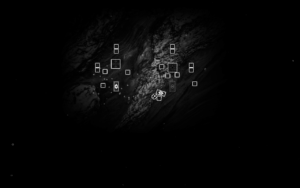
Gameplay is solid and interesting without breaking the unnerving tone set by the aesthetics. Your ship has tank controls with left and right handling rotation while up and down are used for actual movement. Without any weapons, movement is the only real way you have to interact with the environment and, with virtually no death penalty, you are encouraged to poke, prod, and shove at your surroundings. Both the ship and most of the objects you can interact with have a decent amount of momentum to them and Deep Chalk Dive insists upon both accuracy and speed as you loop and curve your way through the abyss. The ultimate goal of the game is to complete over 50 small ‘puzzles’; finishing a puzzle makes its parts gradually fade away and then the next puzzle will appear nearby.
Though I referred to them as puzzles, nearly every one of these tasks requires you to complete one of three objectives or a combination of them. The first, and by far the most common, of these objectives is to push rectangular blocks into certain outlines, which may be hidden behind moveable blocks. The number of blocks present varies from puzzle to puzzle, but it’s usually somewhere from two to four and any block can go into any outline. These blocks are also symmetrical, so you don’t need to worry about which direction they are facing, though you still need to match them up with the angle of the outline; blocks will properly orient themselves to match the outline if the angle or positioning is slightly off, but it can be a bit finicky and it is easy for a block to become rotated while you are pushing it towards its goal. The second task is simply a matter of picking up collectibles scattered around the puzzle’s area and that’s all there is to it. As for the final task, you must hit an orb out of a box, at which point it will make its way towards a specific part of the area and it will start to flash once it reaches its destination. Hitting the orb again once it starts flashing will cause it to move to another area and repeat this process until it inevitably arrives at a large block which serves as the goal; you need to constantly stay near the orb as failing to hit it within a few seconds after it starts flashing will make it vanish and appear back at the start.
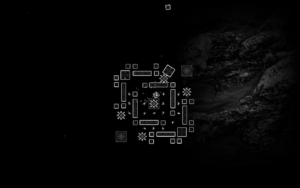
So far this game may sound rather easy, but there are quite a few obstacles which can make it surprisingly difficult to complete these simple tasks. A light in the center of your ship serves as your health indicator and taking damage will make it dimmer, though it also automatically regenerates fairly quickly. The most obvious obstacles are the blocks themselves as they define the play area and bumping into them can cause damage to your ship. Learning to distinguish between the jittering, unmovable blocks and the stabilized blocks which you can push helps both when it comes to creating new paths and for avoiding damage because bouncing up against a wall in a corner or a tight space can result in your ship becoming mercilessly juggled between blocks until it is destroyed. The blocks which occasionally drift down from the top of the screen aren’t just for aesthetic purposes either as they can get in your way or, worse, push ceiling blocks down into the main play area to unexpectedly complicate otherwise easy objectives. Beyond the blocks, large mines are the most common danger and they come in two forms. Dormant mines will hover in one place or slowly move in a fixed pattern and can even be pushed out of the way with the help of a block, though they will soon drift back to their original location and later puzzles feature mines which remain invisible until you get near them. Active mines look the same as the dormant ones, but if you get near them they will reveal an eye-like light in their center and start to follow you until you move far enough away. Some puzzles include a few blocks with lights in them which can be pushed at a mine or placed in its path to make the mine explode on contact, but mines will quickly respawn at a designated tile and then move back to their original location after being destroyed so it is usually better to weave around dormant mines and lure active ones away unless you are trapped or want to disrupt their movement. Mines can also push blocks and a significant portion of the challenge comes from figuring out the best way to navigate a block to an outline and properly line it up without a mine pushing it into a troublesome area or angle.
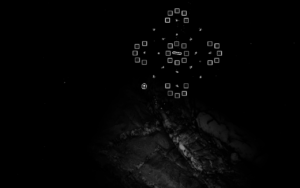
There are plenty of other hazards beyond mines and blocks too, all of which keep in line with the subdued atmosphere. Flat, rotating artifacts will shoot out a constant beam of invisible energy which will rapidly drain your ship’s health on contact and you can define the general location of this deadly force either by paying attention to the location of small markings on the artifact itself or by looking at the many small bubbles the otherwise invisible beam creates as it moves. Later on, stationary blocks are added into the mix which create a similar type of hazard in the form of a large circle around them and you must navigate through narrow passages between the health-draining circles created by these blocks. Though not as much of a threat as other hazards, ‘block generators’ exist which create random chains of appearing and disappearing blocks near them, which mostly serve to get in your way while you’re trying to avoid other dangers, but they can still cause serious damage to your ship if you get caught in a cluster of blocks while trying to move near them. The closest thing Deep Chalk Dive has to a tangible enemy, and one which you will see quite a lot of near the end, comes in the form of enormous stationary squares which send out fast-moving energy orbs in a straight line towards your ship. Just two hits from these projectiles are enough to destroy the ship and this enemy periodically sends out bursts of these orbs, which can be completely devastating if you are facing two or more of these enemies simultaneously. These hazards are gradually introduced over the course of the game and, despite the large number of puzzles, the gameplay never feels stale as a new obstacle or a new combination of obstacles and tasks inevitably becomes introduced to freshen things up whenever the game starts to feel like it’s winding down.
Using the environment to your advantage is the most compelling aspect of Deep Chalk Dive’s gameplay. Blocks can get in your way, but they can also hinder mines, shield you from projectiles, and be set up to slow down an orb on the way to its destination so you can more easily reach it before it starts flashing. Blocks which can be interacted with are also frequently mixed in with immobile ones and noticing a ‘solid’ block or two within a cluster of jittery ones can open up new paths to make puzzles much easier to complete. You are also never confined to the space of the puzzle for your solutions. If the area between a rectangular block and its outline is littered with mines you can try to face the danger and push the block across the area, but you can also push it out into the black void and more safely move it to the other side from beyond the puzzle’s general perimeter. The invisible beams of the rotating artifacts can be avoided or dashed through if you’re at full health, but you can also choose to push the artifact itself far away from the puzzle to more safely complete your task. If a mine is chasing you, you can always use it to push blocks or to shield you from projectiles and the projectiles from the giant squares can likewise be utilized to move big clusters of blocks. Nearly every task can be effectively approached in multiple ways and most obstacles can help just as much as they hinder if used well.
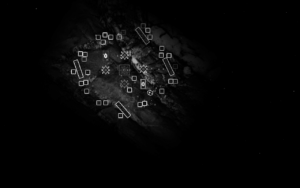
Plenty of polish and clever pacing help to hold everything together. The game tells you to ‘Press Start’ at the beginning and which of the Shift keys you use to start determines if your controls are tied to the WASD keys or the arrow keys. On top of this, you need to navigate your ship to bump into a ‘New Game’ block, which helps to familiarize you with the general controls before the game even begins. Local multiplayer is also supported and a second player can join in or leave at any point by pressing and holding their respective Shift key; there isn’t splitscreen support, but the camera will pan out as the players move away from each other and you can put a very large amount of distance between the two ships before you are prevented from moving farther away. Multiplayer aside, the camera starts claustrophobically close to the player’s ship, which can be useful for pushing blocks at precise angles or if you just want to look more closely at the scenery, but you can easily change the zoom to include an area large enough too easily see the entirety of nearly any puzzle in the game. If you decide to explore the featureless void or get separated from the current puzzle for one reason or another, yet another button exists for panning the camera over to the location of the puzzle so you can never become hopelessly lost.
Furthermore, this game is very difficult and I died at least once on the majority of puzzles, and significantly more times than once on more than a few, but there is no sense of atmosphere-shattering frustration involved because the death penalty is virtually nonexistent. Running out of health causes your ship to drift for a second or two before it pops into a cloud of bubbles and immediately respawns, usually outside of the range of any possible danger, with no loss of progress; the low penalty may make the game seem overly forgiving despite its otherwise fairly high degree of difficulty, but it’s the best way to preserve the atmosphere and to encourage players to take risks and experiment with their surroundings. In the unlikely event of a puzzle somehow becoming nearly impossible to complete or of the positions of mines and blocks simply becoming too messy to easily deal with, there’s even a button to reset the current puzzle and the game is automatically saved every time a puzzle is completed. Last, but certainly not least, Deep Chalk Dive manages to create its impressive atmosphere and to introduce players to all of its mechanics without cutscenes, without definable characters, and with no words beyond instructions to press start, blocks to start a new game or load an old one, and a brief readme file to explain the basic controls.
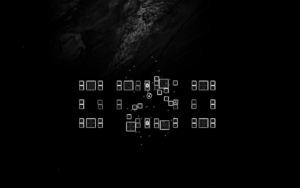
Deep Chalk Dive makes excellent use of space to create a world which is as compellingly mysterious as it is passively menacing and to create a gameplay experience where experimentation is welcomed and encouraged while maintaining a frustration-free degree of ruthless difficulty. Though some may be hesitant to give this game a chance because it might come across as being an ‘artsy game’, absolutely nothing about Deep Chalk Dive comes across as pretentious and it blends entertaining gameplay with a surprisingly unique atmosphere in a way which allows the two to synergize with and strengthen each other rather than sacrificing one for the sake of the other. This is a game which excels in just about every area and I absolutely recommend giving it a try.